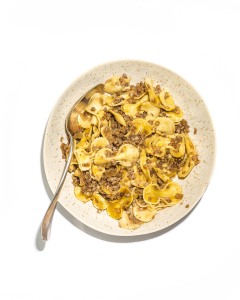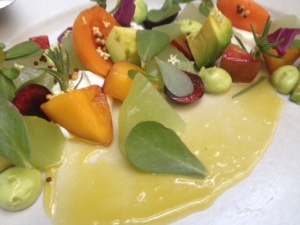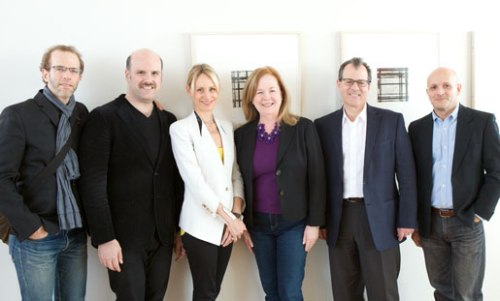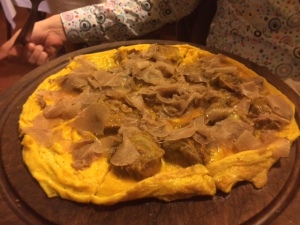
Tortino with artichokes and white truffles at Buca dell’Orafo
If I add it up, I think I’ve spent about a full year’s worth of time in Florence over the last 20 years or so. About six months of that time I must have spent eating. And Florence’s food offerings still charm me with old favorites and new finds. In town a few weeks ago to give a keynote address at the conference Florence: A City of Many Appetites, on the 500th anniversary of the publication of Machiavelli’s The Prince, I was able satiate my own appetites between panels and presentations in a few of my favorite haunts.
First, a few notes on trends spotted on this visit:
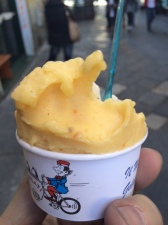
Seasonal persimmon gelato at Vestri
Likely due to the economic realities of Italy right now and the outsize success of a few popular holes in the wall, panini shops have taken hold of Florence like cupcake shops in Manhattan. There used to be a few famous places—my favorites were Nerbone in the Mercato Centrale, I Fratellini, by the Duomo, and Antica Noe near the gelateria Vestri—but now you see one on every block. What is sad is that only a few are busy. One, All’Antico Vinaio, is so busy it must be the inspiration for everyone’s hope. Everyone presumes that those that are the busiest must have the best sandwiches and the freshest ingredients. But you really never know. The popular are just the ones most written about.
Also new to me this trip are the glass boxes outside ristorantes and caffès on historic piazzas, which seem to have replaced tents to protect “outdoor” tables and chairs. Especially at night, these illuminated cubes seem like elegant cages in which to view gesticulating Italians having a good time. These see-through cubes may have been a function of the season (we were visiting in November), but sitting inside any of them on the warm, sunny days we were fortunate to have was not appealing.
Food
Buca dell’Orafo
Via dei Girolami, 28r
Tel. +39-055 213619
This is my favorite restaurant in town. Maybe my favorite restaurant in Italy. Nate’s, too. It’s right near the Ponte Vecchio, in a covered alleyway that leads to the Uffizi. It’s an old place, but locals I know wouldn’t go near it because of the location—too touristy—until a gastronomically trustworthy friend insisted. The restaurant, run by Giordano Monni, is tiny and attracts mainly a local crowd. Totally seasonal, classic and creative Tuscan dishes are all prepared with care, most better than anywhere else I’ve had them. From the fritto misto of vegetables to the bistecca alla fiorentina, to the pastas, the soups, and desserts, everything I’ve ordered (which is just about everything) has been great. Other favorites include the tortino (omelet), which is sometimes made with porcini, sometimes artichokes, white truffles in season. The tortino’s delicious flavor and creamy texture defy its few basic ingredients, eggs, olive oil, salt, vegetables. If your are a fan of anchovies, order the classic Jewish Italian dish of plump, anchovies, grilled bread and butter. The pastas are all perfect. Gnudi (ricotta dumplings in browned butter with sage) were excellent, gnocchi were light and delicate. And the secondi are all deeply satisfying, particularly the signature gropa scalopata (layers of rare grilled beef with pecorino, black pepper, fried herbs and olive oil). Desserts, a chocolate cake or a poached pear, are also lovely. And get a bowl of bocconcini Dai Dai, little bites of vanilla semi freddo covered in chocolate and hand wrapped in paper from an artisanal gelateria in a small town not far away. We went to Buca dell’Orafo twice in four days and were sorry we didn’t go more.
All’Antico Vinaio di Firenze
Via de’ Neri, 65
Tel. +39-055 2382723
We finally broke down and got on line with 25 or 30 others to try this, the most popular panini shop in Florence. You will know this place when you arrive because there is always a line and crowds of people crouching on the street eating oversized sandwiches. (Nate called it “the Artichoke Pizza of Florence.” I think it may be more like Magnolia Café.) The hordes come because this former hole in the wall has received a lot of Trip Advisor recommendations (the most in the world, in fact) and because they won a televised street food competition. And honestly, it’s pretty good. They stuff salumi or porchetta sliced to order into warm schiacciata (Tuscan focaccia) and condiment it with spreads of artichoke or eggplant or cheese, and top it with marinated eggplant, sliced tomatoes, and whatever else you want. For five euros the oversized sandwiches are a deal, even if the wait is taxing. Pour your own wine, honor system, two euros for all you can drink.
Club del Gusto
Via De’ Neri, 50/r
Tel. +39-348 0903142
Funny to be recommending this tiny tripe restaurant that’s across the street from All’Antica Vinaio (see above). We went in looking for a quick plate of pasta, assuming that a tripe shop would really only cater to locals, which it does. And the pastas, made to order by the owner, who chops the garlic and squishes the tomatoes once he hears what you are having, are very satisfying. (To me, it’s like the Shopsin’s of Florence.) Rigatoni with pancetta and pecorino were perfectly satisfying. The meatballs in tomato sauce obviously home made and delicious. The surprise is that the primi and secondi are all about five euros apiece. A satisfying lunch for ten euros is a surprise anywhere. That we enjoyed so much is even more shocking. Note, that the exemplary Gelateria dei Neri is just down the street.
Ganzo
Via dei Macci, 85r
Tel. +39-055 241076
Ganzo is an unusual restaurant. Actually, it’s not really a restaurant. It’s a classroom and a private gourmet club run by the students of the Apicius International School of Hospitality. It’s open for brunch and special dinners and aperitivi for members (anyone can become a member) and there’s usually something interesting going on. It’s run by the students, overseen by their professional chef/instructors, who are being graded while they work and learn. There’s a beautiful outdoor lounge area, and some lovely other sitting environments. Stop by and do your part for hospitality education.
Cocktails
Hotel Continentale
Rooftop Bar
Vicolo dell’Oro, 6R
Tel. +39-055 27262
Located at the base of the Ponte Vecchio, this outdoor, rooftop lounge has become our favorite place in Florence for cocktails. It’s atop the boutique Continentale hotel, part of the Ferragamo family’s chain. Even the elevator ride is entertaining. An iPad allows you to take selfies on the way up or you can change the ambient music. On the roof the setting is white and chic, the views of Palazzo Vecchio, the Oltrarno, and Brunelleschi’s dome are amazing. The soundtrack is chill. And the drinks are good. The aperitivi snacks used to be more substantial, but this time all we got was a big bowl of olives. Still, a perfect respite, day or night.
Four Season Firenze, Atrium Bar
Borgo Pinti, 99
Tel. +39-055 26261
The Four Seasons has raised the bar, almost too high, that is, too stiff, perhaps, for a sophisticated hospitality environment in Florence. Previously, you had to take a taxi ride up to Villa San Michele if you wanted such a formal setting for a drink. This is just a 10-minute walk from the duomo. It’s not full of Florentines, but it is full of beauty. During the day, the atrium let’s in gorgeous light, and the gardens of the hotel are magnificent. The whole thing is very grown up, piano music, and all, and the cocktails and snacks are, too. The hotel has a Michelin-starred fine dining restaurant, too, that’s very good, but pricey.
Gelato
Vestri
Borgo degli Albizi, 11r
Tel. +39-055 2340374
No trip to Florence for me is complete without a stop in this chocolate shop cum gelateria. Signore Vestri is a master. Each gelato is superb, with the chocolate-based ones bordering on sublime. Chocolate mint, chocolate cinnamon, chocolate orange, and chocolate chili (which has a pleasant kick in the aftertaste), are like eating the frozen center of fine truffles. Pistachio is “Wow!” A friend I led there once commented, “It’s so perfect, it seems French.”
Rivareno
Via Borgo Degli Abizi, 46/r
Tel. +39-055 0118039
There is plenty of good gelato in Florence (Carabè, Gelateria dei Neri, Badiani, Grom, Cantina del Gelato). Like Grom, the new Rivareno is part of a national chain. Also like Grom, the quality is excellent. Of particular note is the pleasingly chewy texture of their gelato. Don’t let the sterile space turn you off. Their dark chocolate is like frozen chocolate pudding. Just down the street from Vestri, it pains me to have to divide my allegiances, but they are both really good.
Caffès/Pasticceria
Caffè Libertà
Piazza della Libertà, 26
Tel. +39-055 474978
This is my favorite caffè in Florence, where you’ll find my favorite pastries in town. It’s a little off the beaten path, north of the center, on the Piazza Libertà, but I think it’s worth the trip, and I always go for one breakfast, at least, and hopefully two. Daily life unfolds in this caffè as you sit under the arcade and watch elegantly dressed women in high heels pull up on their bicycles to grab a cappuccino and a pastry on their way to work alongside workmen taking a break from a nearby construction job. And the pastries and salati (mostly panini) are, I think, the best in the city. Don’t miss the sfoglia, a glazed puff pastry turnover filled with vanilla pastry cream, or sweetened ricotta, or chocolate, or chocolate and pear, that may be the best puff pastry thingamagig I’ve ever had. The Florentine classic budino di riso (rice custard tart) is the best I’ve found in town, too They have decent coffee, too. A great place to sit and watch the real city unfold. And they are open (and very busy) on Sundays.
Fedora
Via Guelfa, 116
Tel. +39-055 2658135
Like Ganzo, this jewelbox of a pasticceria is operated by students of the Apicius International School of Hospitality. It’s overseen by pastry chef Simone de Castro, and the quality and beauty of the offerings, not to mention the environment, are on par with the best in town. Maybe better.
One final note, this trip I was intrigued by a new, expensively renovated place near Santa Croce called Cucina Torciacoda. It turned out to be only one month old and not one but five separate food operations in one: a pizzeria, an osteria, a ristorante, a gelateria, and a shop. It clearly cost a fortune to remodel, and I thought we should check it out. We had lunch in the Osteria. DON’T. It was horrible and will forever go down in history as the only time I’ve been served pasta in Italy that was inedible. Gloppy and disgusting. We regretted we wasted an entire meal time.

Shekerato at Caffè Libertà

Seasonal persimmon gelato at Vestri

Gropa scalopata at Buca dell’Orafo

Baccalà on chickpea puree at Ganzo

Tortino with artichokes and white truffles at Buca dell’Orafo

Porchetta panino on warm schiacciata at Antico Vinaio

“Pumpkin pie” at Bistrot Targa

Porchetta at Antico Vinaio

Gnudi at Buca dell”orafao

Riccotta gelato at Grom

The line at Antico Vinaio

Tortino with porcini and white truffles at Buca dell’Orafo

Bolito panino from Nerbone in Mercato Centrale, 130 years ahead of the panino craze

Satisfying lunch bargains at Club del Gusto

Grandma’s ravioli at Antica Noe’s trattoria


